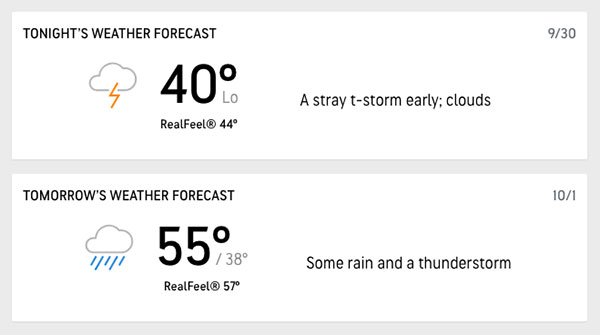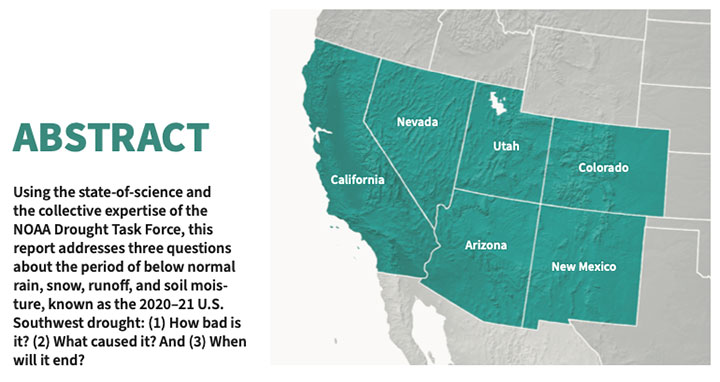A new report by the NOAA Drought Task Force found that the exceptional 2020–21 Southwestern drought was caused by a combination of successive seasons of low precipitation (most likely due to natural variations in climate) and natural and human-caused warming…
— from the latest issue of the email newsletter ‘Dry Times’ published by the National Integrated Drought Information System
I’m looking out the window at 2pm, on the last day of September, watching the drizzling rain. We’ll probably see some snow on the San Juan Mountains tomorrow morning, but maybe I won’t be able to see it, because the weatherman says we should expect rain clouds again tomorrow.
Which will be “today” when I post this editorial. So keep your umbrella handy.

Predicting the weather has become more scientific lately, for the simple reason that the people who want the weather predicted, hire only scientists. If they hired news editors instead, weather prediction would be less scientific, but maybe just as accurate.
I mean, this isn’t rocket science. A rocket is fully self-contained and wrapped in steel or aluminum. Once you build a rocket, it pretty much stays the way you built it, for better or worse. Weather, on the other hand, is scattered all over the globe, continuously moving from here to there, and constantly adjusting its attitude. Weather prediction is more closely related to a casino slot machine than to a rocket.
But the NOAA Drought Task Force has been hard at work, studying the “exceptional 2020-21 Southwestern drought”, which was caused by… something. And will probably end… at some point.
We know a few things for certain. A period of less-than-normal rainfall and higher-than-normal temperatures, between January 2020 and August 2021, affected numerous people — farmers, ranchers, water districts, golf course owners — who are especially concerned about water supplies. Rather than cry over spilt milk, NOAA (National Oceanic and Atmospheric Administration) gathered 25 climate scientists and other experts to answer three basic questions.

1) How bad is it?
2) What caused it?
3) When will it end?
The team was led by Justin S. Mankin (Assistant Professor, Department of Geography, Dartmouth College), Isla Simpson (Scientist 2, Climate and Global Dynamics Laboratory, National Center for Atmospheric Research), Andrew Hoell (Meteorologist, NOAA Physical Sciences Laboratory), and Rong Fu (Professor, Department of Atmospheric & Oceanic Sciences, UCLA). You can download the report here.
The easiest part of the scientific work, it seems, was answering question number 3. “When will it end?”
Drought conditions will improve when water supply from precipitation increases, water demand from high temperatures decreases, or some combination thereof occurs. Because the successive seasons of below-average precipitation appear to have come from natural, but unfavorable, variations in the atmosphere and ocean, precipitation may return to pre-2020 drought levels at some point after Winter 2021-2022…
My non-technical translation: “The drought will end when it rains more, and temperatures cool off somewhat. Maybe soon. Maybe not so soon.”
I find it interesting to note, here, that the 25 scientists ended up concluding that the 2020-21 drought resulted from “natural” causes. More about that in a moment.
Question 1 — “How bad was it?” — was not much harder to answer. First, though, we need to understand what “drought” means. From the report:
What is Drought?
Drought occurs when a water deficit at the land surface ensures that water demands cannot be met.
My non-technical translation: “A drought means, people want to access more water than is available.”
Then we have some additional scientific terms.
Drought is typically defined based on where water supply and its demand are being considered. For example, most droughts begin due to a period of low precipitation, creating what is known as a meteorological drought. At some point, the low precipitation can dry soils, leading to an agricultural drought. Finally, if river and stream flow is impacted, the drought can become a hydrologic drought. It is important to note three things: first, not all meteorological droughts become agricultural or hydrologic droughts. Second, agricultural or hydrologic droughts can occur without a meteorological drought, such as through poor human management. Finally, the major socioeconomic impacts of droughts tend to be associated with hydrologic and agricultural droughts, as they more directly affect human-managed systems, like hydropower and agriculture.
The report then reminds us that California suffered some major fires, which we can easily blame on the 2020-21 drought. According to the National Interagency Fire Center, about 5.9 million acres burned between January 1 and September 30, 2021, and about 7.7 million acres burned during the same time period in 2020.
What the NOAA report neglected to mention is that, in 2015, 9 million acres burned during those same months, and 8.8 million acres burned in 2012. In fact, looking back through 2011, five of the past eleven years saw more wildfire damage than 2020 or 2021.
2021 wasn’t even close to our worst year for wildfire.
So, how bad was it? Well, it was bad because California, Arizona and Nevada have been consistently draining more water out of America’s largest water reservoir — Lake Mead — than has been flowing into the reservoir, and they’ve finally figured out that you can’t keep doing that. So it was bad, but maybe it was also good? Facing reality might actually be a positive step.
Question number 2. “What caused it?”
The 2020–21 Southwestern U.S. drought was caused by an unfortunate combination of variations in climate that led to a sequence of low precipitation seasons (most likely natural) beginning in the winter of 2019–20, and by both natural and human-caused warming.
My non-technical translation: “It didn’t rain enough; and it was hot, so things dried out faster.” And yes, an unfortunate combination.
But did 2020-21 justify the following illustration?

These people are scientists, right? It looks to me like this thermometer is registering 150º Fahrenheit.
As I finish this, Part One of this editorial series, it’s 6:30am on Friday, and as far as I can tell, it’s been raining for most of the night. The house is a bit chilly, and I’m wearing a sweater. According to Accuweather.com, the temperature outside is about 45º F. It’s still too dark to see if we have fresh snow on the mountains, but I’m guessing we do.
Santa Fe, NM, is currently having rain, and expecting thunderstorms later today. In Flagstaff, AZ, it’s clear and 35º. Grand Junction is 53º and cloudy. Truly, all weather is ‘local’, in much the same way all politics is ‘local’.
Back in 2014, a journalist named Kate Galbraith wrote an article for the Columbia Journalism Review about her ongoing fascination with water issues, and also wondering why the subject finds relatively little coverage in the mainstream media, compared to, say, energy.
She also made this comment.
Water is fundamental, and the strains on communities will only grow more intense as population growth continues and climate change brings more severe droughts and floods, particularly to the arid West. So what to write about? Drought, when it hits, provides a good starting point; as the saying goes, a crisis is a terrible thing to waste.
I’ve heard that phase before, at water district meetings. That “a drought is a terrible thing to waste”… if your intention is to generate concern about the future.
Should we be fearful?
Personally, I have my own strategy laid out. If we run out of water, I plan to drink beer.
